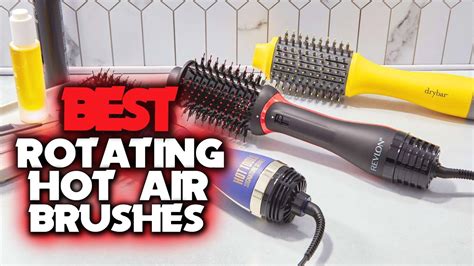Hot air brushes are a popular hair styling tool that can be used to create a variety of looks, from smooth and sleek to voluminous and curly. They work by combining hot air with a rotating brush to dry and style your hair at the same time.

1. Benefits and Features of Hot Air Brushes
Hot air brushes offer a number of benefits, including:
- Convenience: Hot air brushes are a one-step styling tool that can save you time and effort.
- Versatility: Hot air brushes can be used to create a variety of looks, from smooth and sleek to voluminous and curly.
- Control: Hot air brushes give you more control over your styling than traditional blow dryers.
- Volume: Hot air brushes can add volume to your hair, making it look thicker and fuller.
2. Types of Hot Air Brushes
There are two main types of hot air brushes:
- Round brushes: Round brushes are designed to create smooth, sleek styles. They come in a variety of sizes, from small to large.
- Paddle brushes: Paddle brushes are designed to create volume and lift. They have a flat, rectangular shape and are typically larger than round brushes.
3. How to Use a Hot Air Brush
To use a hot air brush, follow these steps:
- Wash and condition your hair as usual.
- Towel dry your hair to remove excess moisture.
- Apply a heat protectant spray to your hair.
- Section your hair into small sections.
- Starting at the roots, place the hot air brush under a section of hair and roll it towards the ends.
- Hold the brush in place for a few seconds, then release and move on to the next section.
4. Tips for Using a Hot Air Brush
Here are a few tips for using a hot air brush:
- Use a low heat setting: Hot air brushes can get very hot, so it’s important to use a low heat setting to avoid damaging your hair.
- Start with the roots: When you’re using a hot air brush, start at the roots and work your way down to the ends. This will help to create a smooth, even style.
- Move the brush slowly: Don’t move the hot air brush too quickly through your hair. This will help to prevent frizz and damage.
- Use a heat protectant spray: A heat protectant spray will help to protect your hair from heat damage.
- Let your hair cool down: After you’ve finished using the hot air brush, let your hair cool down for a few minutes before touching it. This will help to set your style.
5. Troubleshooting Hot Air Brush Problems
If you’re having problems with your hot air brush, here are a few troubleshooting tips:
- The brush is not rotating: If the brush is not rotating, check to make sure that the power cord is plugged in and that the switch is turned on. You may also need to clean the brush by removing any hair or debris that may be blocking the rotation.
- The brush is too hot: If the brush is too hot, turn down the heat setting. You may also need to move the brush more quickly through your hair.
- The brush is damaging my hair: If the brush is damaging your hair, you may be using it too frequently or on too high of a heat setting. You may also need to use a heat protectant spray.
Conclusion
Hot air brushes are a versatile hair styling tool that can be used to create a variety of looks. They are easy to use and can save you time and effort. By following the tips in this article, you can use your hot air brush to create beautiful, healthy hair.
Frequently Asked Questions
Q: What is the difference between a hot air brush and a blow dryer?
A: Hot air brushes combine hot air with a rotating brush to dry and style your hair at the same time. Blow dryers only blow hot air, which can cause frizz and damage.
Q: What type of hot air brush is best for my hair type?
A: Round brushes are best for creating smooth, sleek styles. Paddle brushes are best for creating volume and lift.
Q: How often should I use a hot air brush?
A: You should not use a hot air brush more than once or twice a week. Using it too frequently can damage your hair.
Q: Can I use a hot air brush on wet hair?
A: No, you should not use a hot air brush on wet hair. This can cause frizz and damage.
Q: What is the best way to clean a hot air brush?
A: To clean a hot air brush, remove any hair or debris from the brush. You can also use a damp cloth to wipe down the brush.
